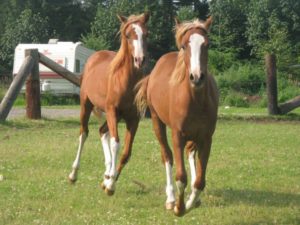
What does eggs per gram of feces really mean? That’s a question we are often asked here at Horsemen’s Laboratory. When we say a horse is passing 1000 strongyle eggs/gm of feces a day, that gives us an estimate of how quickly and thoroughly a horse is contaminating its environment—the pasture in this case—with eggs that could become infective larvae for pasture mates. The best way to explain how infective a pasture could become is with an example. The setting for this example is based on one horse (a high shedder) on one acre (44,000 sq. ft.) of pasture 24 hours a day and passing a conservative amount of stool (40 lbs.) containing 1000 strongyle eggs/gm. of feces per day. We’ll use the numbers below in our formulas:1 lb = (approximately) 460 gm; 1 acre = 44,000 square feet (sq. ft.); 1 sq. ft. = 144 square inches (sq. in.); 1 square inch is slightly larger than a postage stamp. The impact of just one high shedding horse on a pasture could be as follows: 40 lbs ´ 460 gms ´ 1000 (eggs per gm) = 18,400,000 eggs per day. That’s 6+ billion per year! Horsemen’s Laboratory owner Dr. John Byrd has extensive experience with racing and breeding horses and oversees Westbrook Boarding Stable. He created Horsemen’s Laboratory in 1992 so that horse owners could better evaluate their worm control programs and make informed decisions about deworming their horses. Visit www.horsemenslab.com to learn more about Horsemen’s Laboratory and parasites and to order testing kits. You can also order kits by calling 1-800-544-0599.
Published May 2013 Issue

The Northwest Horse Source is an independently owned and operated print and online magazine for horse owners and enthusiasts of all breeds and disciplines in the Pacific Northwest. Our contemporary editorial columns are predominantly written by experts in the region, covering the care, training, keeping and enjoyment of horses, with an eye to the specific concerns in our region.






